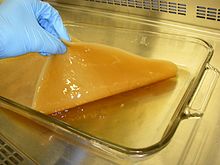

Bacterial cellulose is an organic compound with the formula (C
6H
10O
5)
n produced by certain types of bacteria. While cellulose is a basic structural material of most plants, it is also produced by bacteria, principally of the genera Komagataeibacter, Acetobacter, Sarcina ventriculi and Agrobacterium. Bacterial, or microbial, cellulose has different properties from plant cellulose and is characterized by high purity, strength, moldability and increased water holding ability.[1] In natural habitats, the majority of bacteria synthesize extracellular polysaccharides, such as cellulose, which form protective envelopes around the cells. While bacterial cellulose is produced in nature, many methods are currently being investigated to enhance cellulose growth from cultures in laboratories as a large-scale process. By controlling synthesis methods, the resulting microbial cellulose can be tailored to have specific desirable properties. For example, attention has been given to the bacteria Komagataeibacter xylinus due to its cellulose's unique mechanical properties and applications to biotechnology, microbiology, and materials science.
Historically, bacterial cellulose has been limited to the manufacture of the jelly-like desserts nata de piña and nata de coco, a Filipino food product.[2][3][4] With advances in the ability to synthesize and characterize bacterial cellulose, the material is being used for a wide variety of commercial applications including textiles, cosmetics, and food products, as well as medical applications. Many patents have been issued in microbial cellulose applications and several active areas of research are attempting to better characterize microbial cellulose and utilize it in new areas.[1]
- ^ a b Jonas, R.; Farah, Luiz F. (1998). "Production and application of microbial cellulose". Polymer Degradation and Stability. 59 (1–3): 101–106. doi:10.1016/S0141-3910(97)00197-3.
- ^ Iguchi, M.; Yamanaka, S.; Budhiono, A. (2000). "Bacterial cellulose' a masterpiece of nature's arts". Journal of Materials Science. 35 (2): 261–270. Bibcode:2000JMatS..35..261I. doi:10.1023/A:1004775229149. S2CID 81685441.
- ^ Sutanto, Agus Tri (2012). "Pineapple Liquid Waste as Nata De Pina Raw Material". Makara, Teknologi. 16 (1): 63–67. doi:10.7454/mst.v16i1.1286. S2CID 56381771.
- ^ Vergara, Benito S.; Idowu, Panna Melizah H.; Sumangil, Julia H. (1999). Nata de Coco: A Filipino Delicacy (PDF). National Academy of Sciences and Technology, Philippines. ISBN 9718538615. Archived (PDF) from the original on 2021-06-28. Retrieved 2021-03-07.